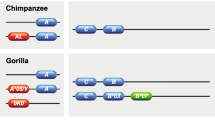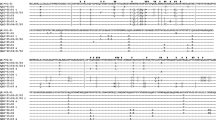Abstract
The human major histocompatibility complex (MHC) region encodes three types of class II molecules designated HLA-DR, -DQ, and -DP. Both the HLA-DQ and -DP gene region comprise a duplicated tandem of A and B genes, whereas in macaques, only one set of genes is present per region. A substantial sequencing project on the DQ and DP genes in various macaque populations resulted in the detection of previously 304 unreported full-length alleles. Phylogenetic studies showed that humans and macaques share trans-species lineages for the DQA1 and DQB1 genes, whereas the DPA1 and DPB1 lineages in macaques appear to be species-specific. Amino acid variability plot analyses revealed that each of the four genes displays more allelic variation in macaques than is encountered in humans. Moreover, the numbers of different amino acids at certain positions in the encoded proteins are higher than in humans. This phenomenon is remarkably prominent at the contact positions of the peptide-binding sites of the deduced macaque DPβ-chains. These differences in the MHC class II DP regions of macaques and humans suggest separate evolutionary mechanisms in the generation of diversity.






Similar content being viewed by others
References
Amicosante M et al (2001) Beryllium binding to HLA-DP molecule carrying the marker of susceptibility to berylliosis glutamate beta 69. Hum Immunol 62:686–693
Blancher A, Aarnink A, Yamada Y, Tanaka K, Yamanaka H, Shiina T (2014) Study of MHC class II region polymorphism in the Filipino cynomolgus macaque population. Immunogenetics 66:219–230. doi:10.1007/s00251-014-0764-7
Bondinas GP, Moustakas AK, Papadopoulos GK (2007) The spectrum of HLA-DQ and HLA-DR alleles, 2006: a listing correlating sequence and structure with function. Immunogenetics 59:539–553. doi:10.1007/s00251-007-0224-8
Bontrop RE, Watkins DI (2005) MHC polymorphism: AIDS susceptibility in non-human primates. Trends Immunol 26:227–233. doi:10.1016/j.it.2005.02.003
Breed MW et al (2015) Elite control, gut CD4 T cell sparing, and enhanced mucosal t cell responses in Macaca nemestrina infected by a Simian immunodeficiency virus lacking a gp41 trafficking motif. J Virol 89:10156–10175. doi:10.1128/JVI.01134-15
Creager HM et al (2011) Characterization of full-length MHC class II sequences in Indonesian and Vietnamese cynomolgus macaques. Immunogenetics 63:611–618. doi:10.1007/s00251-011-0537-5
Crooks GE, Hon G, Chandonia JM, Brenner SE (2004) WebLogo: a sequence logo generator. Genome Res 14:1188–1190. doi:10.1101/gr.849004
Dai S et al (2010) Crystal structure of HLA-DP2 and implications for chronic beryllium disease. Proc Natl Acad Sci U S A 107:7425–7430. doi:10.1073/pnas.1001772107
de Groot N, Doxiadis GG, De Groot NG, Otting N, Heijmans C, Rouweler AJ, Bontrop RE (2004) Genetic makeup of the DR region in rhesus macaques: gene content, transcripts, and pseudogenes. J Immunol 172:6152–6157
de Groot NG et al (2012) Nomenclature report on the major histocompatibility complex genes and alleles of Great Ape, Old and New World monkey species. Immunogenetics 64:615–631. doi:10.1007/s00251-012-0617-1
Deng Q et al (2013) Identification of Mamu-DPA1, Mamu-DQA1, and Mamu-DRA alleles in a cohort of Chinese rhesus macaques. Immunogenetics 65:901–904. doi:10.1007/s00251-013-0736-3
Divis PC et al (2015) Admixture in humans of two divergent Plasmodium knowlesi populations associated with different macaque host species. PLoS Pathog 11:e1004888. doi:10.1371/journal.ppat.1004888
Doxiadis GG et al (2013) Haplotype diversity generated by ancient recombination-like events in the MHC of Indian rhesus macaques. Immunogenetics 65:569–584. doi:10.1007/s00251-013-0707-8
Doxiadis GG, Otting N, de Groot NG, Bontrop RE (2001) Differential evolutionary MHC class II strategies in humans and rhesus macaques: relevance for biomedical studies. Immunological Rev 183:76–85
Doxiadis GG, Rouweler AJ, de Groot NG, Louwerse A, Otting N, Verschoor EJ, Bontrop RE (2006) Extensive sharing of MHC class II alleles between rhesus and cynomolgus macaques. Immunogenetics 58:259–268. doi:10.1007/s00251-006-0083-8
Flynn JL, Gideon HP, Mattila JT, Lin PL (2015) Immunology studies in non-human primate models of tuberculosis. Immunological Rev 264:60–73. doi:10.1111/imr.12258
Gonzalez-Galarza FF et al (2015) Allele frequency net 2015 update: new features for HLA epitopes, KIR and disease and HLA adverse drug reaction associations. Nucleic Acids Res 43:D784–D788. doi:10.1093/nar/gku1166
Gough SC, Simmonds MJ (2007) The HLA region and autoimmune disease: associations and mechanisms of action. Curr Genomics 8:453–465. doi:10.2174/138920207783591690
Gyllensten U, Bergstrom T, Josefsson A, Sundvall M, Erlich HA (1996) Rapid allelic diversification and intensified selection at antigen recognition sites of the Mhc class II DPB1 locus during hominoid evolution. Tissue Antigens 47:212–221
Haanstra KG et al (2013) Induction of experimental autoimmune encephalomyelitis with recombinant human myelin oligodendrocyte glycoprotein in incomplete Freund’s adjuvant in three non-human primate species. J Neuroimmune Pharmacol 8:1251–1264. doi:10.1007/s11481-013-9487-z
Hernandez RD et al (2007) Demographic histories and patterns of linkage disequilibrium in Chinese and Indian rhesus macaques. Science 316:240–243. doi:10.1126/science.1140462
Jones EY, Fugger L, Strominger JL, Siebold C (2006) MHC class II proteins and disease: a structural perspective. Nat Rev Immunol 6:271–282. doi:10.1038/nri1805
Karl JA, Heimbruch KE, Vriezen CE, Mironczuk CJ, Dudley DM, Wiseman RW, O’Connor DH (2014) Survey of major histocompatibility complex class II diversity in pig-tailed macaques. Immunogenetics 66:613–623. doi:10.1007/s00251-014-0797-y
Kean LS, Singh K, Blazar BR, Larsen CP (2012) Nonhuman primate transplant models finally evolve: detailed immunogenetic analysis creates new models and strengthens the old. Am J Transplant 12:812–819. doi:10.1111/j.1600-6143.2011.03873.x
Kumar S, Stecher G, Tamura K (2016) MEGA7: molecular evolutionary genetics analysis version 7.0 for bigger datasets. Mol Biol Evol 33:1870–1874. doi:10.1093/molbev/msw054
Ling F et al (2011) Characterization of the major histocompatibility complex class II DOB, DPB1, and DQB1 alleles in cynomolgus macaques of Vietnamese origin. Immunogenetics 63:155–166. doi:10.1007/s00251-010-0498-0
Mooij P et al (2015) Synthetic long peptide booster immunization in rhesus macaques primed with replication-competent NYVAC-C-KC induces a balanced CD4/CD8 T-cell and antibody response against the conserved regions of HIV-1. J Gen Virol 96:1478–1483. doi:10.1099/vir.0.000074
Mudd PA et al (2012) Vaccine-induced CD8+ T cells control AIDS virus replication. Nature 491:129–133. doi:10.1038/nature11443
O’Connor SL et al (2007) Comprehensive characterization of MHC class II haplotypes in Mauritian cynomolgus macaques. Immunogenetics 59:449–462. doi:10.1007/s00251-007-0209-7
Otting N, Bontrop RE (1995) Evolution of the major histocompatibility complex DPA1 locus in primates. Hum Immunol 42:184–187
Otting N, de Groot N, de Vos-Rouweler AJ, Louwerse A, Doxiadis GG, Bontrop RE (2012) Multilocus definition of MHC haplotypes in pedigreed cynomolgus macaques (Macaca fascicularis). Immunogenetics 64:755–765. doi:10.1007/s00251-012-0632-2
Otting N, de Groot NG, Doxiadis GG, Bontrop RE (2002) Extensive Mhc-DQB variation in humans and non-human primate species. Immunogenetics 54:230–239. doi:10.1007/s00251-002-0461-9
Robinson J, Halliwell JA, Hayhurst JD, Flicek P, Parham P, Marsh SG (2015) The IPD and IMGT/HLA database: allele variant databases. Nucleic Acids Res 43:D423–D431. doi:10.1093/nar/gku1161
Sano K et al (2006) Novel cynomolgus macaque MHC-DPB1 polymorphisms in three South-East Asian populations. Tissue Antigens 67:297–306. doi:10.1111/j.1399-0039.2006.00577.x
Schneider TD, Stephens RM (1990) Sequence logos: a new way to display consensus sequences. Nucleic Acids Res 18:6097–6100
Silveira LJ et al (2012) Chronic beryllium disease, HLA-DPB1, and the DP peptide binding groove. J Immunol 189:4014–4023. doi:10.4049/jimmunol.1200798
Smith DG, McDonough J (2005) Mitochondrial DNA variation in Chinese and Indian rhesus macaques (Macaca mulatta). Am J Primatol 65:1–25. doi:10.1002/ajp.20094
t Hart BA, Bogers WM, Haanstra KG, Verreck FA, Kocken CH (2015) The translational value of non-human primates in preclinical research on infection and immunopathology. Eur J Pharmacol 759:69–83. doi:10.1016/j.ejphar.2015.03.023
Thorsby E, Lie BA (2005) HLA associated genetic predisposition to autoimmune diseases: genes involved and possible mechanisms. Transpl Immunol 14:175–182. doi:10.1016/j.trim.2005.03.021
van der Wiel MK, Otting N, de Groot NG, Doxiadis GG, Bontrop RE (2013) The repertoire of MHC class I genes in the common marmoset: evidence for functional plasticity. Immunogenetics 65:841–849. doi:10.1007/s00251-013-0732-7
Xie G et al (2013) Association of granulomatosis with polyangiitis (Wegener’s) with HLA-DPB1*04 and SEMA6A gene variants: evidence from genome-wide analysis. Arthritis Rheum 65:2457–2468. doi:10.1002/art.38036
Acknowledgments
The authors wish to thank Francisca van Hassel for preparing the figures and Donna Devine for editing this article.
This work was supported by the National Institute of Health projects (NIH/NIAID HHSN272201100013C).
Author information
Authors and Affiliations
Corresponding author
Electronic supplementary material
Below is the link to the electronic supplementary material.
Suppl. Table 1
(PDF 221 kb)
Suppl. Figure 1
Maximum Parsimony analysis of HLA-DQA1 and Mafa-DQA1 sequences. The evolutionary history was inferred using the Maximum Parsimony method. The most parsimonious tree with length = 618 is shown. The consistency index is (0.478011), the retention index is (0.803879), and the composite index is 0.448768 (0.384264) for all sites and parsimony-informative sites. The percentages of replicate trees in which the associated taxa clustered together in the bootstrap test (500 replicates) are shown next to the branches. The tree is drawn to scale, with branch lengths calculated using the average pathway method and are in the units of the number of changes over the whole sequence. The human sequences are depicted in green: bovine sequences, used as an out-group, are depicted in blue. (PDF 181 kb)
Suppl. Figure 2
Maximum Parsimony analysis of HLA-DPA1 and Mafa-DPA1 sequences. The evolutionary history was inferred using the Maximum Parsimony method. The most parsimonious tree with length = 387 is shown. The consistency index is (0.416667), the retention index is (0.752525), and the composite index is 0.371401 (0.313552) for all sites and parsimony-informative sites. The percentages of replicate trees in which the associated taxa clustered together in the bootstrap test (500 replicates) are shown next to the branches. The tree is drawn to scale, with branch lengths calculated using the average pathway method and are in the units of the number of changes over the whole sequence. The HLA-DPA1 sequences are depicted in green. Non-primate full-length DPA1 sequences, to use as an out-group, were not available. (PDF 133 kb)
Suppl. Figure 3
The DPA1-DPB1 pairs in the macaque cohorts. The pairs are sorted on the DPA1 lineages. Only those pairs are listed that were observed in at least two animals. The pairs A-F are identical sets of alleles in different macaques species. Abbreviations. Indo B: Indonesian cynomolgus macaques held at the BPRC. Indo A: Indonesian cynomolgus macaques held at AlphaGenesis inc. Ca/Vi: Cynomolgus macaques of Cambodian and/or Vietnamese origin. India B: Indian rhesus macaques held at the BPRC. India O: Indian rhesus macaques held at the ONPRC. Chin: Rhesus macaques of Chinese origin. Sang: Pigtailed macaques analyzed by Sanger sequencing. NGS: Pigtailed macaques analyzed by NG sequencing. (PDF 233 kb)
Rights and permissions
About this article
Cite this article
Otting, N., van der Wiel, M.K.H., de Groot, N. et al. The orthologs of HLA-DQ and -DP genes display abundant levels of variability in macaque species. Immunogenetics 69, 87–99 (2017). https://doi.org/10.1007/s00251-016-0954-6
Received:
Accepted:
Published:
Issue Date:
DOI: https://doi.org/10.1007/s00251-016-0954-6




